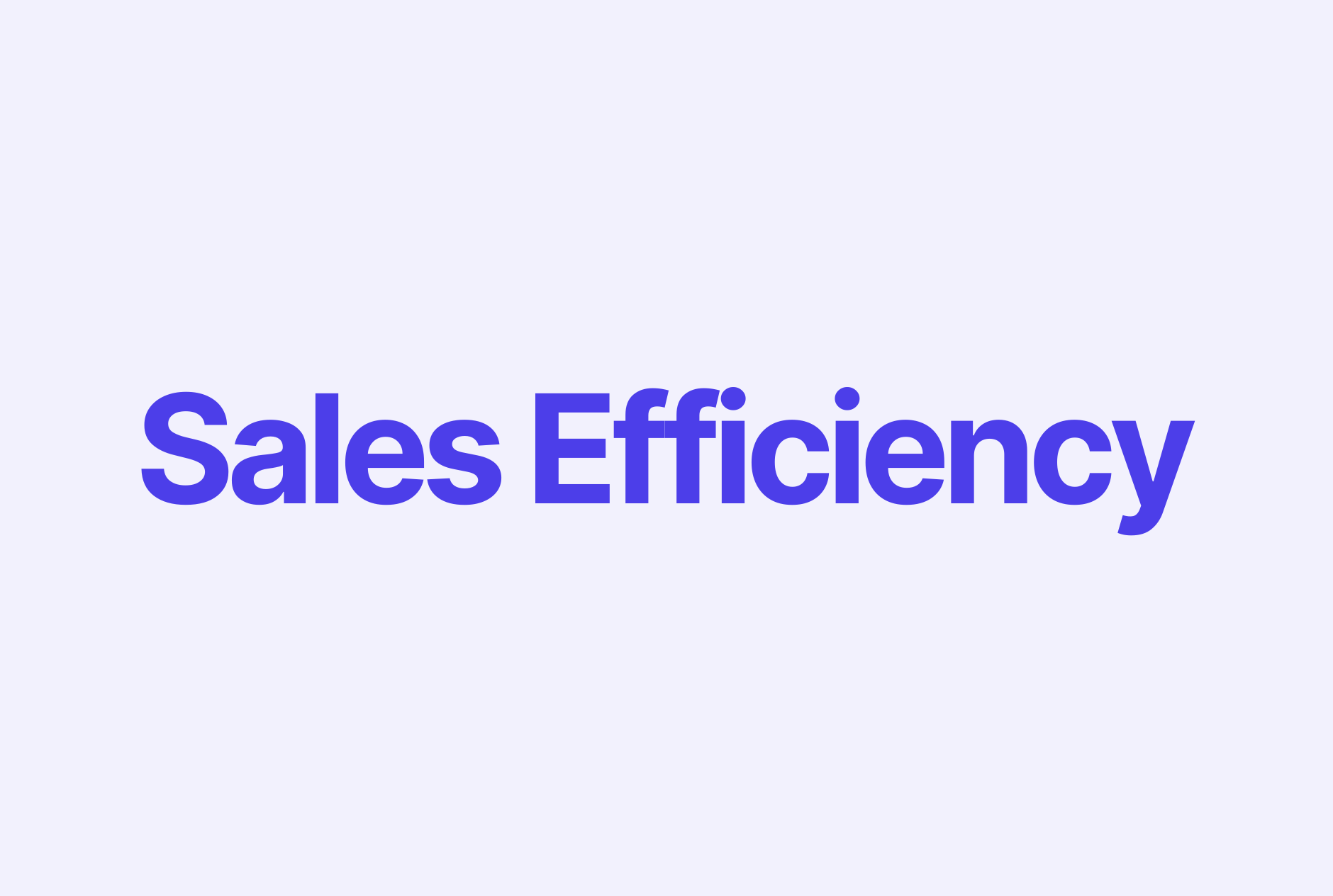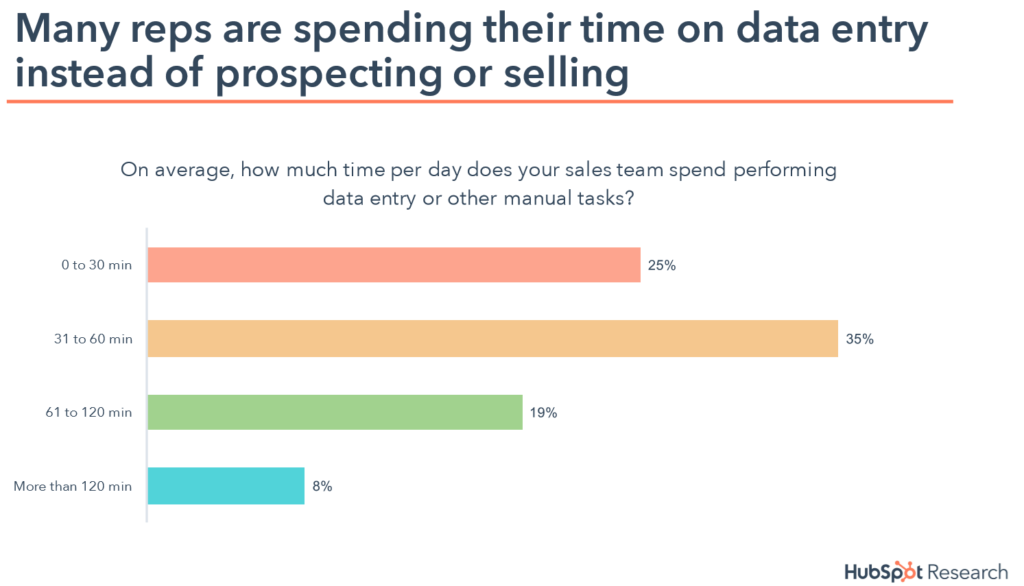Improving Sales Efficiency: The Complete Guide for Sales Leaders

Does this sound familiar: Like most sales leaders, you take time at the start of each quarter or fiscal year to set targets and strategize how you’re going to hit them.
But when it’s go time, things don’t quite hit the mark as planned.
Inefficient sales processes, poor execution, and disheartened sales teams all lead to low sales efficiency. In this guide, we'll show you six strategies you can use to improve sales efficiency.
What is sales efficiency?
Sales efficiency is the speed at which your sales operations create value. It quantifies how quickly your reps are converting leads into prospects and prospects into customers—and at what cost.
Breaking down sales efficiency into a number is a way to demonstrate the payoff of investing in your sales team.
For example, SaaS companies often prioritize product promotion, events, and sales enablement when it comes to budget planning. This number can help build the case that investing in your sales team will drive X amount of return.
Sales efficiency vs. sales effectiveness
“Sales efficiency” and “sales effectiveness” are terms often used synonymously, but they’re not the same.
- Sales effectiveness is your sales team’s ability to convert leads into customers at different stages of the sales cycle. If you have an effective sales process, you’ll see more wins than losses at each stage.
- Sales efficiency is how quickly you’re able to convert leads into customers while still bringing in the highest return on your investment.
Your sales process needs to be both effective and efficient to close deals in a reasonable amount of time, at a sustainable cost, and on the right terms.
How to calculate sales efficiency
Sales efficiency can be calculated with the following formula:
Sales Efficiency = Revenue / Sales & Marketing Costs
Simply divide the gross revenue your sales team generates by the cost it incurs while doing so (e.g. salaries, training, and equipment).
For example, if a sales team generates $2 million in revenue with $1 million in sales & marketing costs, it would have a sales efficiency of 2. In other words, for every $1 your company spends on sales, it would generate $2.
Gross sales efficiency vs. net sales efficiency
We also differentiate between gross sales efficiency and net sales efficiency.
1. Gross sales efficiency
Gross sales efficiency looks at incremental increases in revenue over a fixed period:
Gross Sales Efficiency = New Annual Recurring Revenue / Sales & Marketing Costs
2. Net sales efficiency
Net sales efficiency offsets that incremental increase by any loss in revenue from churn during the same period:
Net Sales Efficiency = Net New Annual Recurring Revenue / Sales & Marketing Costs
(Net New ARR = Ending quarter ARR - Beginning quarter ARR - Lost ARR)
How to improve sales efficiency
In this section, we're going to guide you through five strategies you can use to improve sales efficiency.
1. Set SMART goals
Clarity is key. You need to clearly define what you want to achieve and share these goals with your reps so you’re all on the same page.
SMART goals can help you do that
- Specific
- Measurable
- Attainable
- Relevant
- Time-bound
With sales efficiency, the "measurable" part is especially important.
In other words, having the right sales efficiency KPIs in place as benchmarks for how your reps are performing and what’s expected from them.
For example, what should the lead response time be? Or the number of sales calls per rep? Is there a minimum number of deals reps should be closing each month? Do reps have individual revenue targets?
SMART goals provide reps with the necessary guidance to work as efficiently and effectively as possible.
But how you break these goals down and the way you track them plays a role as well. Some of the things most sales teams care about are:
- Sales effectiveness by vertical
- Sales effectiveness by region
- Sales effectiveness by product
- Sales effectiveness based on rep tenure
- Individual rep effectiveness (against the average)
2. Know who you're selling to
Once again, clarity is key. Clearly defining exactly who your target buyer is equips your reps with the context they need to sell their best.
Better yet, provide your team with guidelines on how to best approach this audience, how and where to reach them, and key messaging that aligns with what buyers care about the most.
This level of clarity will help streamline your sales efforts and give your reps time to do what they do best: sell.
3. Maximize sales rep productivity
According to one study, sales reps spend just 37% of their time on revenue-generating tasks.
The rest of their time is spent on things like meetings, checking email, or other admin activities.
One way to maximize rep productivity is having the right sales tools in place (check out our article on the 15 best sales productivity tools!).
Also, it's worth exploring how you can improve your pipeline management (here's our stance on that) to become more productive.
However, if you first want to get an overview of where to improve your process, our article on sales pipeline analysis might be something for you.

Maximize the amount of time sales reps spend actually selling by automating routine sales tasks wherever possible.
There’s a lot of tools out there to help you do this. For example, Weflow can improve productivity by helping update your pipeline faster and organizing all your notes and to-dos in a modern workspace - auto-syncing with Salesforce (it's free!).
4. Prioritize sales coaching
Sales coaching is a continuous process in which sales managers actively help, engage with, and advise sales reps while reinforcing what they learned in training.
It's an iterative, customized, and consistent approach aimed at developing reps' abilities.
Sales coaching starts at new sales rep onboarding and evolves into reviewing sales calls with your reps and talking about what went well and where they could improve.
Another example would be reviewing and offering constructive comments on reps’ email discussions with prospects at different stages of the buyer journey or sales process.
When done right, sales coaching helps you get the most out of your training budget.
In fact, companies that use sales coaching programs have much greater win rates than those that don't—improving your sales efficiency as a result.
5. Join forces with the marketing team
Sales and marketing are stronger, together.
Sales reps rely on Marketing departments to provide them with quality leads. Marketers need to understand what Sales needs to most effectively deliver a pitch and help create the necessary enablement content.
Despite this, many marketing and sales teams operate in silos, with little or no communication between them.
One way to solve this is by designating a sales liaison. This is someone who acts as an intermediary for the two departments, transmitting information between them to improve sales efficiency.
Ready to boost sales efficiency?
Sales efficiency gives you vital insights into how effective your sales efforts are and how quickly your organization can grow. By regularly reviewing your sales efficiency score, you can continuously grow, maximizing revenue.
Weflow is a Salesforce productivity workspace. We enable sales teams that use Salesforce to efficiently manage their sales processes and perform fast pipeline, notes, and task updates. Use for free








